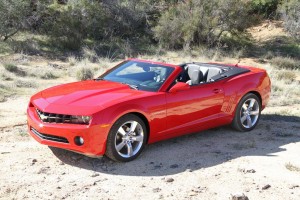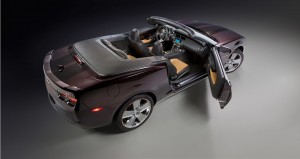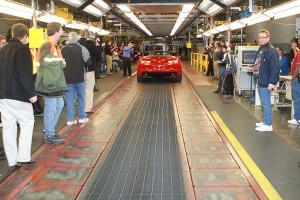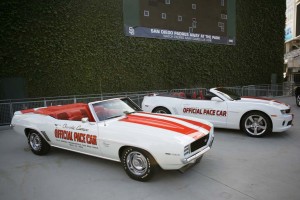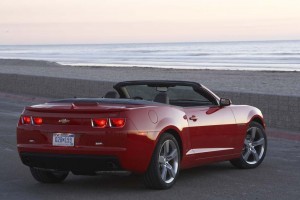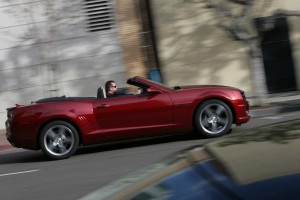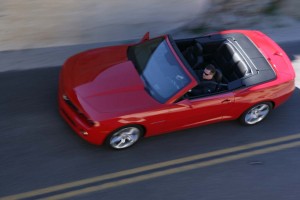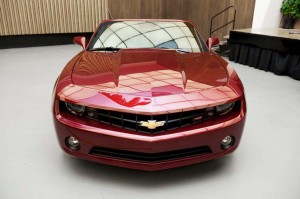For those who’ve been wondering whether General Motors really can get its proverbial mojo back and deliver the sort of products that once propelled it to the head of the class, you only have to look at the new Chevrolet Camaro.
The reborn pony car has won plenty of kudos from the motoring press but, more importantly, it’s won over the hearts, minds and pocketbooks of pony car buyers – last year overwhelming its age-old rival, the Ford Mustang for the first time in a quarter century. That’s all the more impressive when you consider Camaro did it with a coupe alone.
But, just in time for spring, Chevy will be rolling an all-new Camaro Convertible into showrooms, a model the market has been anxiously awaiting since it made its debut, in concept form, at the 2007 Detroit Auto Show. The ragtop was delayed more than a year because of both General Motors’ financial woes and the collapse of the parts manufacturer originally tapped to deliver the foldaway roof.
Ironically, that may have worked out to Chevy’s advantage, laughs Russ Clark, Camaro’s marketing director. History shows that sporty coupes and pony cars tend to have an 18 to 24-month shelf life before buyers head off looking for the next big thing. Ford has wisely read the tea leaves and regularly rolls out significant updates to Mustang to keep demand hot. So, the unplanned delay may have wound up timing things perfectly for Camaro.
Of course, there’s a big caveat: the new Chevy pony car has to hit on all cylinders – whether you’re looking for a V6 or V8. It needs to not only maintain the striking “heritage” looks of the Camaro Coupe but deliver equally good road manners. There’s no room for the wet noodle “boulevard ride,” as Chief Engineer Al Oppenheiser puts it, of Camaros from the not-so-good-old-days.
That prompted GM engineers to make a number of significant changes to the basic Camaro platform – many of which will soon show up in the coupe version, as well, enhancing what is already a solid, but not necessarily benchmark, chassis.
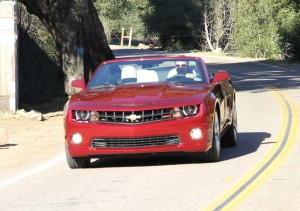
Though about 250 pounds heavier, the Camaro Convertible deliver 0-60 times only 0.2 seconds slower than the Coupe.
How well they succeeded was the question that drew us to San Diego, where Chevy scheduled the first media drive of the 2011 Camaro Convertible. Keys in hand for a 2SS, the top-line version, we headed out to the parking lot where we found the ragtop solidly in place – and making a good impression. One of the first things we noticed – or more accurately, didn’t notice – was the lack of an AM/FM antenna, engineers forming it into the rear quarter panel. They couldn’t do as well with the XM/navi shark fin, however, but went with a body color version on the rear deck.
All too many convertibles lose the lines of their coupe counterparts, canvas hanging off frame rails like the ribs of a hungry horse. The Camaro’s soft top is taut and impressively maintains the shape of the coupe until you fold it away.
The good news is that it takes less than 20 seconds to do so – as long as you don’t want to fit the tonneau cover in place. Better yet, the Camaro is a one-handed affair, electrically operated but for the single, center-mounted manual latch to firmly lock it down. Yes, we’d love the auto-latching design most imports have adopted, but Camaro is still easier to deal with than the dual-latch top of the Mustang.
Sadly, though, that tonneau cover, standard with the top-line V6 and V8 models, will likely just take up space in the trunk or garage. It looks great – if you have the patience to snap it in place. A quick check of our media colleagues, late that afternoon, found few willing to make the effort.
A couple incidental notes: GM’s new supplier puts each top through an eight-minute water test to ensure it doesn’t leak. Meanwhile, the maker decided not to allow you to operate the canvas while moving – a feature Audi and a number of other convertible makers have adopted. Apparently, GM’s legal beagles worry that it’s too much of a distraction, a big no-no with Washington, these days.
When you’re cutting the top off a car the side of a Camaro, you’ve set an ambitious target aiming for what Oppenheiser call “coupe-like ride dynamics.” Anyone who has driven one of the prior-generation ragtops knows what you might expect: a squishy, “re-tuned” ride, using soggy bushings and soft shocks designed to minimize shake, roll and body flex.
To keep – even stiffen – the body tuning, Chevy enhanced key elements of the structure, adding a tower-to-tower shock brace, for example, a transmission support bracket and a tunnel reinforcement brace, to name a few key moves. A hydro-formed tube was added inside the A-pillar, and the windshield header was reinforced.
Chevy data on body stiffness – compared to numbers provided by the competition – suggest the new Camaro Convertible is significantly more rigid than the ragtop Mustang and gives a good chase to the BMW 3-Series Convertible.
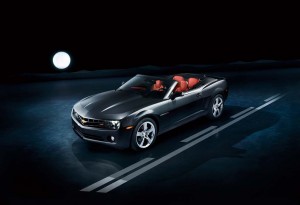
The launch of the Camaro Convertible was delayed more than a year due to GM's financial problems and the collapse of a key supplier.
Yes, there’s some added weight, but at just under 250 extra pounds, it was a reasonably efficient conversion. Notably, the V6 Automatic loses only two-tenths of a second, compared to the coupe version, racing from 0 to 60 in 6.2 seconds. With the V8 and the 6-speed manual, you’ll get there in 4.9 seconds.
Did all the extra work pay off? We spent most of the day tearing through the desert mountain country southeast of San Diego, a maze of narrow switchbacks and torturous climbs and plunges and, for the most part, found that Chevrolet really did engineer a convertible that could satisfy a serious coupe fan. The asterisk on that comment? Oddly, on a few segments of straight-and-level, but rather rough pavement we suddenly experienced some serious steering column shake.
It only occurred a couple times over a route of several 100 miles and never left us wondering what would happen next, but it was disconcerting, the first episode. According to Oppenheiser, we hit precisely the right combination of speed and road conditions to set the chassis in motion.
Would this get us to hedge what we say about the car? No. When we needed a solid platform, under hard driving around seriously challenging corners, the Camaro Convertible performed with absolute aplomb.
Now, let’s face it, there are some other trade-offs, notably trunk space. You’ll get an airline roll-on bag into the back, maybe along with a small computer bag. What was a surprise was that the back seat was no more compromised than with the coupe. No, you wouldn’t want to be back there for a trip from San Diego to San Francisco, but a couple adults could squeeze in.
The downside is that they’ll likely get wind burn. The relatively low windshield doesn’t do much to keep the gusts out of the cabin, front or back. Having just driven the much less compelling new Chrysler 200 Convertible on the same roads, a few days earlier, we did miss the fold-up wind blocker that made it possible to stay out of the breeze and chat, in near-normal voice, with the co-pilot.
One pleasant note: the ragtop features an acoustic liner that really does a good job at minimizing noise. And the top’s design doesn’t limit visibility much more than the already-compromised coupe’s tin roof.
Of course, with the top down you can gather in the full glory of the LS3 6.2-liter V8. Making 426 horsepower, it’s a joy in a straight line, if just a wee bit heavy when you’re navigating the mountain roads. It’s rated at 16/24 with the manual, incidentally, though as with the 3.6-liter V6, you can order it with automatic. The smaller engine makes a still respectable 312 hp and yields 17 mpg City, 28 Highway.
With the base 1LT trim and suspension you’ll lay out $30,000 after delivery, about $2,000 more than the starting price of the comparable Mustang Convertible. Go for the V8 in top-line 2SS trim and you’re up at $40,500, including delivery.
Is it worth the extra money over Ford’s pony car? Part of the decision will likely depend on whose flag you like to fly on race day. Loyalties run deep in this part of the automotive world. But for those whose embraced the new Camaro Coupe, the 2011 Chevrolet Camaro Convertible will be an equally pleasant surprise. It’s solid, sporty and just a blast to drive. With this second model in the line-up, Mustang salespeople are likely to get a little worried in the months ahead.

